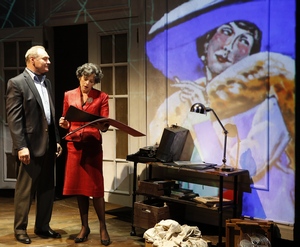Search Curtainup
SITE GUIDE
REVIEWS
REVIEW ARCHIVES
ADVERTISING AT CURTAINUP
FEATURES
NEWS
Broadway
Off-Broadway
NYC Restaurants
BOOKS and CDs
OTHER PLACES
Berkshires
London
California
New Jersey
DC
Philadelphia
Elsewhere
QUOTES
TKTS
PLAYWRIGHTS' ALBUMS
LETTERS TO EDITOR
FILM
LINKS
MISCELLANEOUS
Free Updates
Masthead
A CurtainUp Review
Bauer
By Elyse Sommer
|
Order and disorder. That's all we have.—"Rudolf Bauer, rummaging through his unused, dust-covered studio as he awaits the arrival of the former lover and business partner who he feels betrayed him.
|

L-R: Sherman Howard and Stacy Ross
(Photo: Carol Rosegg)
|
But while Rothko is well known, that's less likely to be the case for Rudolf Bauer (1989-1953); that is, unless you saw the recent PBS documentary Betrayal: The Life and Art of Rudolf Bauer on WNET-Thirteen. Yet, during the 1930s in his native Germany Bauer was hailed as the next Wassily Kandinsky and art historians recognize his influence on the establishment of the Guggenheim Museum and on modernists like Jackson Pollock and Willem de Kooning. He nevertheless died a mostly forgotten artist.
Lauren Gunderson's play Bauer now having its New York premiere at 59E59's Theater "A" was inspired by the above mentioned documentary. But Gunderson, who's become one of San Francisco's busiest playwrights, has used the film's facts as a jumping off point for her own take on Bauer's story. Not that she doesn't cover is career in the forefront of the avante-garde, his condemnation and incarceration by the Nazis as one of its detested "Degenerate" artists, the escape to the U.S. with the help of his aristocratic girl friend and copper tycoon Solomon Guggenheim.
But being a playwright not an art historian, Ms. Gunderson is less interested in Bauer's art than why he stopped making it. After all, he was a man for whom to live was to paint, even in a Gestapo prison when scraps of paper and pencils traded for cigarettes had to serve as canvas and brushes. To explore the psychological drama that compelled him to virtually pull the plug on everything that was meaningful to him, Gunderson created an imaginary meeting between the artist, his wife and the woman he feels betrayed his trust.
The time is winter 1953. The setting is the New Jersey seaside home of the 62-year-old reclusive and retired from painting Rudolf and his 50-year-old wife and former maid.
That lonely house was quite a mansion. The tensely anticipated fictional meeting with Hilla von Rebay could have taken place in any of two dozen rooms, but Rudolf insists that only his unused, dust-coverd studio will do. This enables Bill English, the play's director and designer, to transform the theater's small stage into a wonderfully evocative and dramatic single set. The windows give lighting designer Mary Louise Geiger a chance to let some sunlight in to lighten the gloomy atmosphere. The bare walls allow projection designer Micah J. Stieglitz to add some eye-popping images of Bauer's paintings, including a final visual surprise.
By the time Hilla arrives we know that the man before us has sacrificed his life's passion for what he believes to be his artistic soul. We also know that his wife is determined not to allow his bitterness to crush his already fragile physical and emotional well-being — even though it means welcoming the woman she knows Rudolf loved more passionately than her.
As soon as she comes onstage, it's clear that, though she's only a couple of years younger than Bauer, Hilla is still and elegant and formidable presence. (Bravo to costumer Abra Berman for the women's sharply contrasting outfits).
Gunderson's script covers the personal as well as political elements that determine the course of these characters' lives. All three are fully developed for the actors to give emotionally vibrant and layered performances. The two women, who are new to me, also appeared in the original San Francisco production have probably deepened and enriched their roles. Both are excellent, with Ross dominating as the sublimely imperious, awesomely ambitious and often funny Hilla.
Sherman Howard, who is less of a stranger to New York audiences, has taken on the title character's role and does so with considerable sensitivity. He beautifully captures the pained hesitancy and anxiety in the his non-verbal opening moments. He breaks our heart when he unleashes the despair of a man who's shut himself down for too many years.
The dialogue Gunderson has written for this trio to unleash years of regrets and frustrations is stuffed with wry, witty word play. When Hilla sees Louise's hospitality as being "out to get her" and Bauer says she's just trying to be civil, Hilla counters with "Life's too short"for civility. Let's all say what we mean instead."" Even the depressed Rudolf hasn't lost his sense of humor as when he wonders about how anyone can hang a painting on a curved wall such as the one designed for the Guggenheim Museum by Frank Lloyd Wright.
Smart and revealing as all these interchanges are, these type of conversational dramas do tend to get bogged down in too much talk, and a few nips and tucks in Bauer's mid-section would not have been remiss. Still, this is an enjoyable and enlightening look at a largely unfamiliar chapter of contemporary art history.
|
Bauer by Lauren Gunderson Direction and set design by Bill English Cast:Sherman Howard (Rudolf Bauer), Susi Damilano (Louise Bauer), Stacy Ross (Hilla Rebay) Lighting design: Mary Louise Geiger Costume design:Abra Berman Sound design: Theodore J.H. Hulsker Projections: Micah J. Stieglitz Original score:Savannah Jo Lack Scenic Artist: Ewa Muszynska Dialect Coach: Tovah Close Production Stage Manager: Tatjana Genser Originally commissioned and presented by the SF Playhouse in association with the Weinstein Gallery 59E59 Theaterswww.59e59org Running Time: 90 minutes, no intermissio From 9/02/14; opening 9/09/14; closing 10/12/14 Tuesday - Thursday at 7 PM; Friday at 8 PM; Saturday at 2 PM & 8 PM; Sunday at 3 PM & 7 PM. Reviewed by Elyse Sommer at September 6th press preview |
|
REVIEW FEEDBACK Highlight one of the responses below and click "copy" or"CTRL+C"
Paste the highlighted text into the subject line (CTRL+ V): Feel free to add detailed comments in the body of the email. . .also the names and emails of any friends to whom you'd like us to forward a copy of this review. For a feed to reviews and features as they are posted add http://curtainupnewlinks.blogspot.com to your reader Curtainup at Facebook . . . Curtainup at Twitter Subscribe to our FREE email updates: E-mail: esommer@curtainup.comesommer@curtainup.com put SUBSCRIBE CURTAINUP EMAIL UPDATE in the subject line and your full name and email address in the body of the message. If you can spare a minute, tell us how you came to CurtainUp and from what part of the country. |

|


 Book of Mormon -CD
Book of Mormon -CD